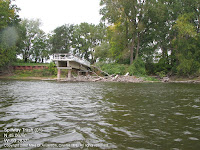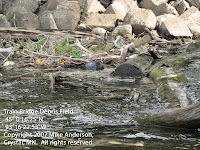+GPS+copy.jpg) (Mending the Mississippi: A Site 3 Project.) So far, we’ve explained “recovery targets” made of some pretty large objects: Concrete and construction debris, scrap iron, tires, and even safes. But the fifth target we’ll focus on is the collection
(Mending the Mississippi: A Site 3 Project.) So far, we’ve explained “recovery targets” made of some pretty large objects: Concrete and construction debris, scrap iron, tires, and even safes. But the fifth target we’ll focus on is the collection  of light trash and “litter” items... some of which have gathered into rather large debris fields. These fields can be waterborne, deposited by the current of a river into an eddy or against a bridge footing… or, wind, waves, current or water recession can deposit the trash onto the shoreline. Any obstruction to the river’s current can cause a debris field to materialize, from man-made piers and docks, to natural obstructions like partially submerged logs or fallen branches.
of light trash and “litter” items... some of which have gathered into rather large debris fields. These fields can be waterborne, deposited by the current of a river into an eddy or against a bridge footing… or, wind, waves, current or water recession can deposit the trash onto the shoreline. Any obstruction to the river’s current can cause a debris field to materialize, from man-made piers and docks, to natural obstructions like partially submerged logs or fallen branches.+copy.jpg) There's a good reason that we have focused on these debris types last; as spring unlocks the ice from this part of the Mississippi, so will it unlock a wide variety of debris items, both upstream and downstream. Just because we had a fix on where these debris fields were located last fall, doesn't mean they'll be in the same place when the ice is out.
There's a good reason that we have focused on these debris types last; as spring unlocks the ice from this part of the Mississippi, so will it unlock a wide variety of debris items, both upstream and downstream. Just because we had a fix on where these debris fields were located last fall, doesn't mean they'll be in the same place when the ice is out. the endless supply of Styrofoam bait containers and plastic bottles and cups he had seen while cruising the river. He opened our eyes to just how much of this crud is floating through our waterways. With regard to harming the waterways, its marine life and adjacent habitat, small trash items can have a major impact. (Please see the postings titled "Paying for our plastic" as well as "Hiding under the snow," both recently published at our sister site, DisposeOfProperly.com.) Plastic bottles and cups, along with other "floatable" debris are among the most important pollutants we can remove in the process of river restoration. Recovery of these items can have a favorable impact not only here in Minnesota, but all the way down the river, to the Delta, into the Gulf of Mexico, and beyond.
the endless supply of Styrofoam bait containers and plastic bottles and cups he had seen while cruising the river. He opened our eyes to just how much of this crud is floating through our waterways. With regard to harming the waterways, its marine life and adjacent habitat, small trash items can have a major impact. (Please see the postings titled "Paying for our plastic" as well as "Hiding under the snow," both recently published at our sister site, DisposeOfProperly.com.) Plastic bottles and cups, along with other "floatable" debris are among the most important pollutants we can remove in the process of river restoration. Recovery of these items can have a favorable impact not only here in Minnesota, but all the way down the river, to the Delta, into the Gulf of Mexico, and beyond.The Google Map below illustrates where these sites are located (click on the link just below the map to enlarge it). As I’ve explained in a previous posting, after enlarging the map it becomes possible to view the area in Google Earth, thus allowing the waypoints on this route to be transferred to your handheld GPS with just a few drag & drop maneuvers.
View Larger Map
The photos within this posting are placed in essentially geographical order, as if you were traveling North to South on the Rice Creek-to-Boom Island route (see Site 3 clean-up). For more information about this project, or to get involved, feel free to drop us an email.
NOTE: Anyone who attempts to recover the items listed in this posting does so at their own risk. Please adhere to the safety instructions and guidelines provided by the DNR. Finally, let me know if you either intend to remove one or more of these items or debris fields, or that you have succeeded in doing so. Simply share your success story email, and we’ll be happy to publish it at CleanUpTheRiver.com.
© 2008 Mike D. Anderson, Crystal, MN.



